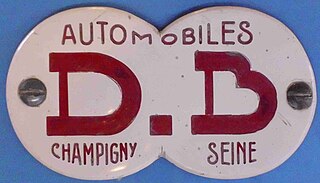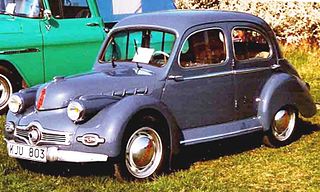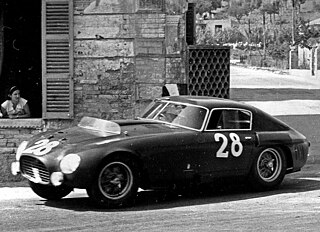
Deutsch-Bonnet (DB), is a brand of sports cars created in 1937 by Charles Deutsch and René Bonnet and disappeared in 1962.

Panhard was a French motor vehicle manufacturer that began as one of the first makers of automobiles. It was a manufacturer of light tactical and military vehicles. Its final incarnation, now owned by Renault Trucks Defense, was formed by the acquisition of Panhard by Auverland in 2005, and then by Renault in 2012. In 2018 Renault Trucks Defense, ACMAT and Panhard combined under a single brand, Arquus.

Ferrari America is a series of top-end Ferrari models built in the 1950s and 1960s. They were large grand touring cars with the largest V12 engines and often had custom bodywork. All America models used a live axle in the rear, were front-engined, and had worm and sector steering.

The Lancia Aurelia is a car produced by Italian manufacturer Lancia from 1950 to the summer of 1958. It is noted for using one of the first series-production V6 engines. Several body styles were offered: 4-door saloon, 2-door GT coupé (B20), 2-door spider/convertible (B24), and a chassis to be custom bodied by external coachbuilders.

The Panhard PL 17 is an automobile made by the French manufacturer Panhard from 1959 until 1965. Presented on 29 June 1959, as successor to the Panhard Dyna Z, the PL 17 was essentially a facelifted version of its predecessor. The initial four-door saloon was joined by the Cabriolet in 1961, and by the Break, a five-door estate version, in April 1963. The Break, developed by Italian company Pan Auto, sat on a longer wheelbase but was of the same overall length.

The Alfa Romeo 1900 is an automobile produced by Italian car manufacturer Alfa Romeo from 1950 until 1959. Designed by Orazio Satta, it was an important development for Alfa Romeo as the marque's first car built entirely on a production line and first production car without a separate chassis. It was also the first Alfa Romeo offered with left-hand drive. The car was introduced at the 1950 Paris Motor Show.

Devin Enterprises was an American automotive manufacturer that operated from 1955 to 1964. Devin was mainly known for producing high quality fiberglass car bodies that were sold as kits, but they also produced automotive accessories as well as complete automobiles. The company was founded by Bill Devin.

The Panhard Dyna X was a lightweight berline designed by the engineer Jean Albert Grégoire and first exhibited as the AFG (Aluminium Français Grégoire) Dyna at the Paris Motor Show in 1946.

The Abarth 205A Berlinetta was a coupé sports car, also known as the Abarth 205A Monza built by Austrian born tuning expert Carlo Abarth in 1950. It was a development of the Abarth Cisitalia 204A but with a new platform chassis, still using the engine and other components from the Fiat 1100 B/E. Only three 205As were finished in 1950; chassis numbers 101, 102, and 103, but an additional car was built in 1953 with an extravagant Ghia body. Slow sales meant that for the next few years Abarth chose to focus on building his exhaust and tuning business, allowing competition and car manufacturing take a backseat. In 1955, the 205A was succeeded by the 207A Spyder and its derivatives.

Marathon was a French automobile manufacturer established by a group of engineers under the leadership of a rally enthusiast called Bernard Denis. Prototypes for a lightweight sports coupé were presented at various motor shows starting with the 1951 Frankfurt Motor Show and the cars were produced between 1953 and 1955.

The Panhard et Levassor Dynamic is a large car introduced by the French auto-maker Panhard et Levassor as a replacement for the company’s CS model at the Paris Motor Show in October 1936.

The Ferrari 375 MM, was a sports racing car produced by Ferrari in 1953 up to 1955 for the road cars. It was named "375" for the unitary displacement of one cylinder in the 4.5 L V12 engine, and the "MM" stood for the Mille Miglia race. In total 26 units were made, including four converted from the 340 MM.

The Panhard CD is a car designed by Charles Deutsch and built by Panhard from 1963 to 1965. The CD was named for Deutsch and is considered a continuation of the line of Panhard-powered vehicles built by Deutsch-Bonnet. The car was the production version of the CD Dyna that raced at Le Mans in June 1962.

The Dynavia is a concept car built by Panhard in 1948. It was built as an experiment in aerodynamics.
Établissements Monopole was a French manufacturing company that produced parts for automobile engines. The company also built and raced a series of small displacement endurance racing cars. After a series of mergers and acquisitions the Monopole name was retired in Europe, but survives in Africa in the name of a former licensee.
Albert Marie Louis Delagarde (1898–1990) was an engineer and automotive designer known primarily for his work with French carmaker Panhard & Levassor.
Louis Bionier (1898–1973) was a French automotive engineer. He is best known as head of chassis development and chief stylist for carbuilder Panhard. He was also involved in the design of some of Panhard's military vehicles.
Pichon-Parat was a French carrosserie based in the commune of Sens, in the department of Yonne. Established in 1952, it was known for producing custom cabriolet, coupé, estate car, and shooting brake conversions of established models from major automakers, and for building their own distinctive sporting models with completely original bodywork.

The OSCA MT4, also spelled the O.S.C.A. MT4 or Osca MT4, is an Italian sports car prototype, designed, developed, and made by Officine Specializzata Costruzioni Automobili, between 1948 and 1956, but was raced and used in active competition until 1966.

















